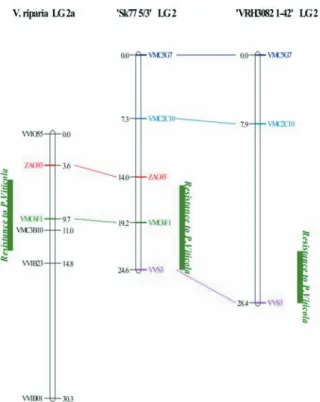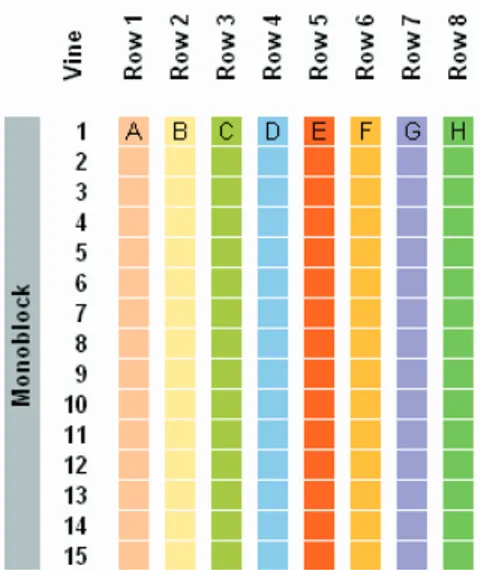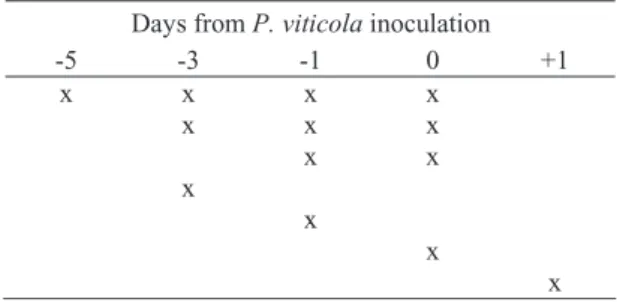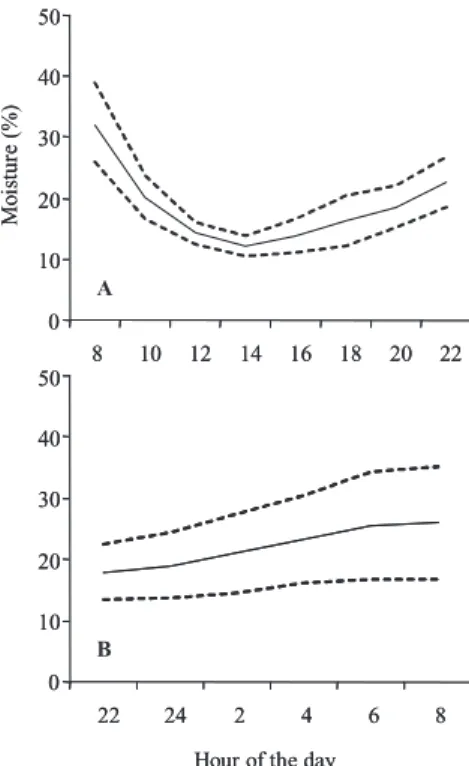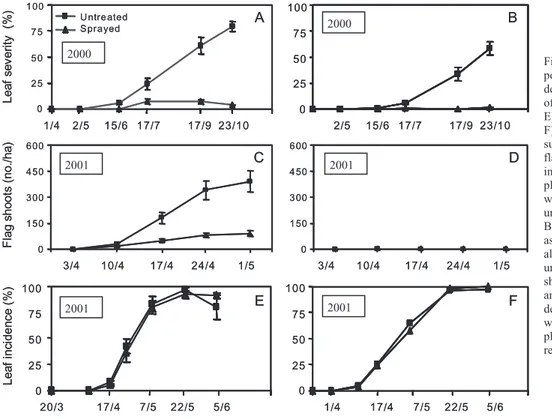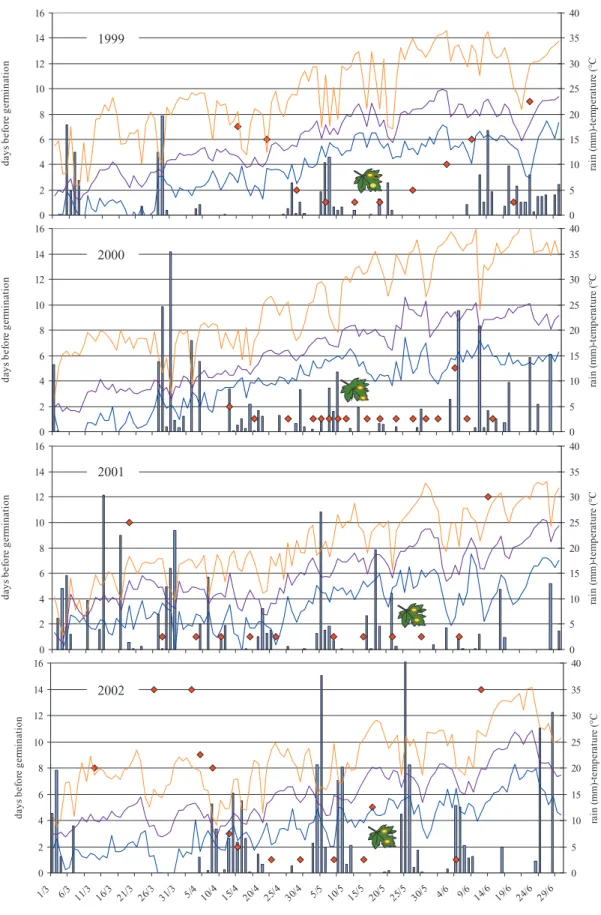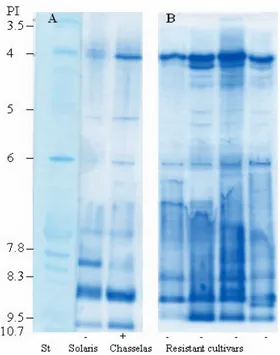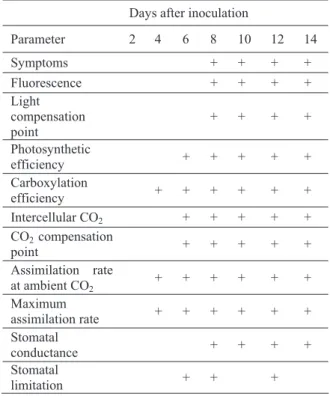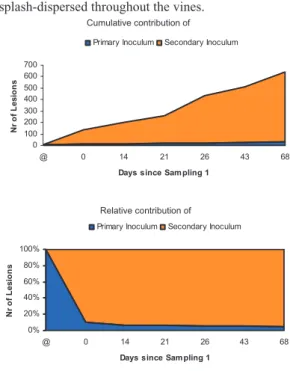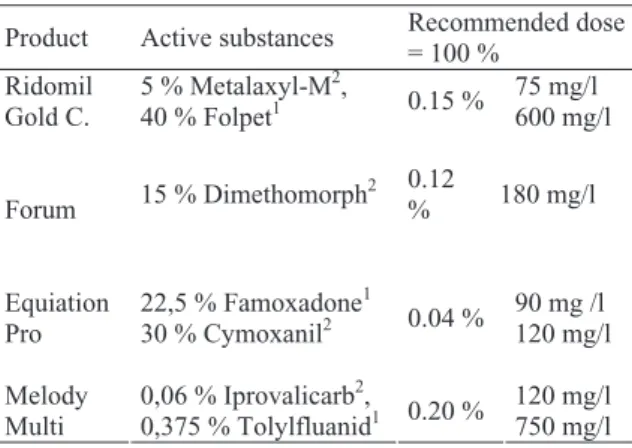Sponsors
We gratefully acknowledge the generous grant support provided by the following agencies
and corporate sponsors:
Table of Contents
Preface
15
Session
1:
17
Host resistance, induced resistance, mechanisms, breeding
Chairperson Robert Seem, Cornell University, USA
Hanns-Heinz Kassemeyer, Tobias Seibicke, Sabine Unger
Host-Pathogen-Interactions and resistance responses of different Vitis genotypes after infection by Plasmopara viticola
Alberto Madini, Flavia M. Moreira, Rosanna Marino, Luca Zulini, Hanns-Heinz Kassemeyer, Pal Kozma, Riccardo Velasco, Marco Stefanini, M. Stella Grando
Candidate genes mapping and comparative QTL analysis for powdery and downy mildew resistance in grape Caterina L. Matasci, Mauro Jermini, Davide Gobbin, Natasha Rosselli, Cesare Gessler
Influence of cultivar mixtures on grapevine Downy mildew epidemic Ilaria Pertot, Silvia Dagostin, Rita Musetti, Davide Gobbin
Activity of the grapevine endophyte Alternaria alternata on infection, colonization and sporulation of Plasmopara viticola in relation to application time
Annalisa Polverari, Marianna Polesani, Filomena Desario, Jessica Knörzer, Nicole Regier, Andreas Kortekamp
Identification of differentially expressed genes in grape following infection with Plasmopara viticola
Sabine Wiedemann-Merdinoglu, Emilce Prado, Christophe Schneider, Pascale Coste, Christine Onimus, Vincent Dumas, Gisèle Butterlin, Alain Bouquet, Didier Merdinoglu
Resistance to downy mildew derived from Muscadinia rotundifolia: genetic analysis and use of molecular
markers for breeding
Silvia Dagostin, Antonella Vecchione, Luca Zulini, Alessandro Ferrari, Ilaria Pertot Efficacy evaluation of the resistance inducer Benzothiadiazole against grapevine downy mildew
Session
2:
31
Biology of the two pathogens, climate interactions and disease expression
Chairperson Hanns-Heinz Kassemeyer, Staatliches Weinbauinstitut, Germany
Tito Caffi, Vittorio Rossi
Water availability in the leaf litter and germination of Plasmopara viticola oospores Shmuel Ovadia, Dani Shtienberg, Amos Dinoor, Abraham Sztejnberg
Do flag shoots serve as the main source of primary inoculum in grape powdery mildew epidemics in Israel? Daniele Prodorutti, Luca Zulini, Antonella Vecchione, Silvia Dagostin, Ilaria Pertot
Germination delay under controlled conditions of over wintered oospores of Plasmopara viticola in Trentino
Region (Northern Italy)
Pere Mestre, Didier Merdinoglu
Analysis of the expression of defense-associated genes in grapevine leaves upon infection by Plasmopara viticola
Anne Poutaraud, Sabine Wiedemann-Merdinoglu, Pascale Coste, Didier Merdinoglu Analysis of stilbene content in leaf discs of grapevine upon inoculation with Plasmopara viticola Sabine Wiedemann-Merdinoglu, Pascale Coste, Rudolf Eibach, Didier Merdinoglu
Comparison of laboratory and vineyard evaluation of grapevine downy mildew resistance in a population derived from a cross between two partially resistant parents
Annemiek C. Schilder, Brian L. Lehman, James A. Flore
Effects of Downy Mildew on Photosynthetic Parameters in ‘Niagara’ Grape Leaves Silvia L. Toffolatti, Marisol Prandato, Antonella Vavassori, Annamaria Vercesi
Germination dynamics of Plasmopara viticola oospores and occurrence of primary infections in Veneto
John D. I. Harper, Sandra Savocchia, Belinda Schirmer, Adrienne R. Hardham, Chris C. Steel, Gavin J. Ash
Immunofluorescence Microscopy of the Cytoskeleton and Associated Components in Zoospores of Plasmopara viticola
Dietrich Stephan, Isabella Linda Bisutti, Katja Hirt
Fermentation and formulation of Pseudomonas fluorescens strain CHA0 and Pf 153 and their influence on the
control of Botrytis cinerea
Santella Burruano, Gaetano Conigliaro, Sandra Lo Piccolo, Antonio Alfonso, Livio Torta Plasmopara viticola: three decades of observation in Sicily
Session
4:
61
Genetic of the pathogens: population genetics, virulence-avirulence, variability and
fungicide resistance
Chairperson David Gadoury, Cornell University, USA
François Delmotte, Fabian Martinez, Alice Némorin, Cyril Dutech, Wei-Jen Chen, Sylvie Richart-Cervera, Marie-France Corio-Costet
Spatial genetic structure of grapevine downy mildew epidemic Felix Hug, Davide Gobbin, Cesare Gessler, Peter A. Magarey
Genetic structure and epidemiology of Plasmopara viticola populations from Australian grape growing regions Walter K. Kast
Genotype fitness and fungicide resistance of Plasmopara viticola
Andreas Kortekamp, Jessica Knörzer, Nicole Regier, Marianna Polesani, Annalisa Polverari
Something new about Plasmopara viticola? A microscopy and molecular biology-based contribution to its
general biology and its effect on grapevine
Davide Gobbin, Artemis Rumbou, Ilaria Pertot, Cesare Gessler
First approach of Plasmopara viticola population biology: merging epidemiology and population genetics Luisa Palmieri, Silvia Dagostin, Alessandro Ferrari, Cesare Gessler
Assessment of Plasmopara viticola oospores germination by gene expression detection of a putative Puf Family
member
Cesare Gessler, Ilaria Pertot, Davide Gobbin
Genetic structure and epidemiology of Plasmopara viticola populations
Session
5:
79
Biological control and agronomical practices
Chairperson Yigal Elad, The Volcani Center and Safecrop Centre, Israel
Ilaria Pertot, Cesare Gessler
Dario Angeli, Claudia Longa, Alessandro Ferrari, Loris Maines, Yigal Elad, Vito Simeone, Haya Abou Assaf, Ilaria Pertot
Efficacy evaluation of new control agents against grapevine powdery mildew under greenhouse conditions Moshe Reuveni, Dani Neifeld, Gregori Pipko, Bili Malka, Tirtza Zahavi
Timorex – A novel tea tree-based organic formulation developed for the control of grape powdery and downy mildews
Session
6:
87
Posters - Genetic of the pathogens: population genetics, virulence-avirulence, variability
and fungicide resistance
François Delmotte, Wei-Jen Chen, Sylvie Richard-Cervera, Lisette Douence, Xavier Giresse, Marie-France Corio-Costet
From molecular evolution to population genetics of strobilurin resistance in grapevine downy mildew populations
Trevor Koopman, Celeste C. Linde, Paul Fourie, Adéle McLeod
The Role of Oosporic Infection in the Epidemiology of Downy Mildew in South Africa Annemiek C. Schilder, Brian L. Lehman, Stephen A. Jordan, Mursel Catal
Pathogenic and genetic variation among Plasmopara viticola isolates from different hosts Vito Simeone, Antonio Guario, Hamid El Bilali, Gianluigi Cesari
Trials testing the efficacy of alternative strategies for the control of powdery and downy mildews in organic vineyards on seven varieties in the Mediterranean environment
Marina Collina, Lucia Landi, Maria Barbara Branzanti, Agostino Brunelli Sensitivity of Plasmopara viticola Italian populations to QoI fungicides Dario Angeli, Enzo Mescalchin, Erika di Marino, Loris Maines
Grapevine powdery mildew and the mycoparasite Ampelomyces quisqualis in Trentino vineyards (Northern
Italy)
Ana Maria Diez-Navajas, Charles Greif, Didier Merdinoglu
Observation of Plasmopara viticola development in grapevine leaves by microscopy and real-time PCR Silvia Dagostin, Davide Gobbin, Ilaria Pertot
Screening of new potential biocontrol agents against Plasmopara viticola using hightroughput method based on
quantitative PCR
Session
7a:
107
Epidemiology, Disease forecasting models, Decision support system, Disease risk
assessment
Chairperson Cesare Gessler, SafeCrop Centre, Italy
Rossi Vittorio, Bugiani Riccardo, Caffi Tito, Giosuè Simona Dynamic simulation of grape downy mildew primary infections
Tito Caffi, Vittorio Rossi, Bugiani Riccardo, Spanna Federico, Flamini Lucio, Cossu Antonello, Nigro Camilla
Walter K. Kast
Statistical Relations between Monthly Means of Temperature and the Sum of Rainfall on Powdery and Downy Mildew
Sven Keil, Henning Immink, Hanns-Heinz Kassemeyer
Effect of temperature and leaf-wetness-duration on the infection severity of the grapevine downy mildew
Plasmopara viticola (Berk. et Curtis ex. de Bary) Berl. et de Toni
Session
7b:
107
Epidemiology, Disease forecasting models, Decision support system, Disease risk
assessment
Chairperson Peter Magarey, South Australian Research and Development Institute, Australia
Forrest W. Nutter, Jr.
Linear vs. Logarithmic Disease Assessment Scales: The Repeal of the Weber-Fechner Law Marc Raynal, Christian Debord, Marc Vergnes, Thierry Coulon
Epicure, a geographic information system applied on downy and powdery mildew risks of epidemics on the bordeaux vineyard
Agnès Calonnec, Philippe Cartolaro, Jean-Marc Naulin, Michel Langlais, Jean-Baptiste Burie, Jean Roman, Gaël Tessier
A powdery mildew/grapevine simulation model for the understanding and management of epidemics
Beate Berkelmann-Loehnertz, Bernd Loskill, Cathleen Fruehauf, Klaus-Uwe Gollmer, Markus Forster, Anja Kuczera, Harald Braden, Peter Wittich
Downy mildew forecast regarding primary and further soil borne infections based on a splash algorithm and a microclimate model
Session
8:
131
Economical and technological aspects of disease management
Chairperson Vittorio Rossi, Istituto di Entomologia e Patologia Vegetale, Università di Piacenza, Italy
Wendy McFadden-Smith, Gary J. Pickering
Juice Composition and Yield from Ontario Vitis vinifera, cultivar Chardonnay Grapes are moderated by severity
of powdery mildew infection
Belinda E. Stummer, Robert G. Dambergs, I. Leigh Francis, Timothy Zanker, Eileen S. Scott
Detection of Powdery Mildew in Grapes using a DNA Assay and Near Infrared Reflectance Spectroscopy, and Assessment of Chardonnay Wine Quality
Session
9:
137
Synthetic and natural fungicides
Chairperson Leonardo Bacci, Dow AgroSciences Italia s.r.l., Italy
Wendy McFadden-Smith
Systemic Activity of Phosphorous Acid against Grapevine Downy Mildew
Opher Mendelsohn, Yigal Elad, Dalia R. David, Dani Shtienberg, Shmuel Ovadia Biological control of powdery mildew – controlled conditions and field experience Carmen Schweikert, H. Heinz Kassemeyer
Systems for testing the efficacy of biofungicides and resistance inducers against grapevine downy mildew (REPCO project)
Alessandro Ferrari, Ilaria Pertot, Silvia Dagostin, Dario Angeli Efficacy of KBV 99-01 against Erysiphe necator and Plasmopara viticola
Ilaria Pertot, Dario Angeli, Alessandro Ferrari, Silvia Dagostin, Cesare Gessler Efficacy of electrolysed acid water against Plasmopara viticola and Erysiphe necator
Wayne F. Wilcox, David M. Gadoury, Judith N. Burr, Robert C. Seem, Duane G. Riegel Properties of Sulfur in Control of Grapevine Powdery Mildew
Session
10:
151
Posters- Epidemiology, Disease forecasting models, Decision support system, Disease
risk assessment - Synthetic and natural fungicides
Philippe Cartolaro, Laurent Delière, Greg Kemmitt, Elizabeth Green
Evaluation of fungicide strategies designed to reduce the number of treatments against Grapevine Powdery Mildew
Guido Spera, Anna La Torre, Luigi Campoli, Riccardo Bugliosi, Massimo Scaglione
Development of non linear forecasting model of Plasmopara viticola infections using Artifìcial Neural
Networks
David M. Gadoury, Robert C. Seem, Wayne F. Wilcox, Megan M. Kennelly, Peter A. Magarey, Ian B. Dry, Doug Gubler, Jay W. Pscheidt, Gary Grove, Turner B. Sutton, Michael A. Ellis, Katherine L. Stevenson, Michael Maixner, Katherine J. Evans
Modeling and Mapping the Relationship Between Climate and Ontogenic Resistance to the Major Fungal Diseases of Grapevine
Alessandro Ferrari, Silvia Dagostin, Ilaria Pertot
Potentials and drawbacks of grapevine downy mildew control with Tecnobiol®, a product based on fatty acids Rita Musetti, Stefano Borselli, Rachele Polizotto, Antonella Vecchione, Luca Zulini, Ilaria Pertot
Dipeptides secreted by the grapevine endophyte Alternaria alternata cause structural damages to Plasmopara viticola
Wayne F. Wilcox, Judith A. Burr
Physical Modes of Action of Phosphites in Control of Grapevine Downy Mildew Hugh D Armstrong, Jodie M Armstrong
Interpretation of correct fungicide dose in commercial vineyards: a global review
Session
11a:
167
Disease management (organic and IPM)
Chairperson Ilaria Pertot, SafeCrop Centre and IASMA Research Centre, Italy
Katherine J. Evans, Peter Crisp, Eileen S. Scott
Applying Spatial Information in a Whole-of-block Experiment to Evaluate Spray Programs for Powdery Mildew in Organic Viticulture
Dario Angeli, Loris Maines, Vito Simeone, Levent Yildiz, Ilaria Pertot
Efficacy evaluation of integrated strategies for powdery and downy mildew control in organic viticulture Robert W. Emmett, Kathleen Clarke, Terry J. Hunt, Peter A. Magarey, Natasha Learhinan
Grapevine bud infection by powdery mildew (Erysiphe necator): Varietal susceptibility and the evaluation of
fungicide treatments to reduce flag shoot development
Mauro Jermini, Danilo Christen, Reto Strasser, Cesare Gessler
Impact of four years application of the Minimal Fungicide Strategy for downy mildew control on the plant recovering capacities of Vitis vinifera cv Merlot
Session
11b:
167
Disease management (organic and IPM)
Chairperson Marc Raynal, ITV France, France
Mark Miles, Gregory Kemmitt, Pablo Valverde, Leonardo Bacci
Results from Two Years of Field Studies to Determine Mancozeb-based Spray Programmes with Minimal Impact on Predatory Mites in European Vine Cultivation
Alice K. Palmer, Katherine J. Evans, Dean A. Metcalf
Aerated compost extract: standardising a new approach for integrated management of powdery mildew Peter Crisp, Eileen S. Scott, Trevor J. Wicks, Paul Grbin
Novel Control of Grapevine Powdery Mildew on a Commercial Vineyard in South Australia: Effects on Disease and Quality
Session
12:
189
Posters - Disease management (organic and IPM)
Sandra Savocchia, Roger Mandel, Peter Crisp, Eileen S. Scott Organic Control of Grapevine Powdery Mildew in Eastern Australia
Dagmar Heibertshausen, Ottmar Baus-Reichel, Uwe Hofmann, Beate Berkelmann-Loehnertz Copper reduction, a successful approach to control downy mildew in organic viticulture
Peter Crisp, Eileen S. Scott, Trevor J. Wicks
Preface
The origin of this story is in the wise recognition of some researchers that the knowledge on
Plasmopara viticola is incomplete and presents many contradictions. So, as a logical
consequence for scientists, a meeting of colleagues was called (Geneva, USA, 1991). After
this first meeting some of us recognized the trueness that the subject is far to be fully
understood and we may have to change our questions and approach. Moreover we realized
that we must join our efforts and stop working alone in our labs and fields to just show
amazing presentations in congresses (Freiburg, Germany, 1994). Some of the purposes
remained empty words, but progresses were slowly made. In the third meeting (Loxton,
Australia, 1998) we have seen some new ideas, approaches and data emerging. The fourth
meeting (Davis, USA, 2002) had to reaffirm the necessity of collaboration and, in some
particular topics, finally more cooperation was started. Being tempted to do our research
alone, come to a workshop, present results and go back home without confront is a risk
always present. We should always remember that doubt and discussion is the driving force
for research. Truly comparing progresses and results, exchanging our information, doubting
that our approach is the only correct one will help us in getting a continuous improvement in
our knowledge. The strict contact with agriculture and markets is an opportunity that will
help us focusing real problems. We are now at the beginning of the fifth meeting and, as
scientists working on powdery and downy mildew of grape, we have few questions to answer
at the end of this week. What are the most important discovers on these two important
diseases? What are the positive benefits to growers and what it is still needed to be solved?
Which approach should we choose: a small group with a clear focused topic and a common
research program discussed prior or a large open group, as wide as possible, so to exchange
information, and pick up new ideas? What do we need to foster common research and/or
development, funding?
This fifth International Downy and Powdery Mildew Workshop will enjoy the hospitality of
Trentino. The reception of the proposal to hold this meeting in San Michele was absolutely
great and, as you will experience, most the major wineries participate with enthusiasms.
However this is also a clear message to us: “bring us better solutions to control downy and
powdery mildew than we currently have”.
We also thank the Istituto Agrario di San Michele all’Adige (IASMA), which hosts us and
offers its infrastructure and experience in organising international scientific meeting. It is
important to mention here that IASMA played and plays, in relation to research on grape and
wine, a prestigious role in Italy. Not at last, we would like to thank all the collaborators of
Safecrop Centre, whose help made this meeting possible.
We thank the “Provincia Autonoma di Trento”, which funded SafeCrop, a centre for research
and development of crop protection with low environment and consumer health impact.
Session 1:
Host resistance, induced resistance,
mechanisms, breeding
Host-Pathogen-Interactions and resistance responses of different Vitis genotypes after
infection by Plasmopara viticola
Hanns-Heinz Kassemeyer, Tobias Seibicke, Sabine Unger
All authors: Staatliches Weinbauinstitut, Dept. Biologie, Merzhauser Str. 119, D-7900 Freiburg im Breisgau, E-mail: [email protected]
___________________________________________________________________________
Grapevine is capable of defending itself against attacks of potential pathogens by a broad spectrum of preformed barriers and inducible defence reactions. All cultivars of Vitis vinifera are susceptible for Plasmopara viticola, whereas wild Vitis species from North America typically express significant resistance to this pathogen. The colonization of susceptible and resistant Vitis genotypes has been studied to get an insight in the time course of resistance response. In addition the resistance response has been characterized on a molecular level.
The course of colonization of the mesophyll by the causal agent of grapevine downy mildew, Plasmopara viticola, in susceptible and in resistant grapevines was examined in order to characterize the development of the pathogen in compatible and incompatible host-pathogen interactions. Within a few hours after inoculation, the pathogen had established in the susceptible Vitis vinifera cv. Müller-Thurgau and formed primary hyphae with a first haustorium. No further development occurred in the following 10 to 18 h. The next developmental step, in which the hyphae grew and branched for colonizing the intercellular space of the host tissue, was observed 36 h after inoculation. After 3 days the intercostal fields were entirely filled with mycelium. The first infection steps were essentially identical in the resistant hybrid V. x vinifera cv. Merzling and V. rupestris. However, further development of the pathogen was incomplete, and the intercostal fields were filled with dense mycelium only in low frequency. In contrast to cv. Müller-Thurgau, P. viticola sporulated rarely on resistant grapevines.
One of the prominent responses after fungal attack is the expression of pathogen related proteins (PRP´s). In order to investigate the response of grapevine to the infection by Plasmopara viticola, the expression of PRP´s has been characterized. For the analysis of a glucanase from grapevine and studies on its induction by P. viticola the structure of the entire gene was elucidated by sequencing of a cDNA clone. Starting from a 3´-fragment of a putative extracellular Vitis-Glucanase a target region was cloned. For this purpose a 3´-primer of the coding sequence was designed and a PCR was performed using a 5´-primer specific for the vector SK-1.
terminus with 36 aminoacids responsible for the transport of proteins in the apoplast indicates this Vitis-glucanase to be extracellular. To confirm the localisation of the expression, parsley protoplasts were transformed with a VGluc-GFP-construct. The expression of the 5´ VGluc-GFP 3` fusion protein constitutively took place under the control of a 35S-CaMV promoter. Microscopical analysis of the protoplasts showed a green fluorescence in the cytoplasma but no fluorescence in the vacuoles. This indicates expression of Vgluc in the cytoplasma and a lacking transport into the vacuoles.
Because glucanases have been described as pathogenesis related proteins the transcription of VGluc after challenge infection should confirm its role in the defence response of grapevine. For this purpose leaves of the same insertion and size from the susceptible Vitis vinifera cv. Mueller-Thurgau and the resistant Vitis rupestris were inoculated with Plasmopara viticola. Within nine days on the susceptible cultivar the manifestation of the pathogen was evident by clearly expressed symptoms and sporulation. In contrast, four to six days after inoculation necrotic spots without any sporulation appeared on the resistant grapevines. In distinct time intervals inoculated and uninfected leaves were collected to extract RNA. Northern blot analysis using a VGluc-cDNA probe revealed an induction of the transcript two days after the challenge infection both in the susceptible and the resistant grapevines. The transcript abundance increased and reached a transient maximum six days after infection.
By means of quantitative PCR (Real-Time-PCR) the course and level of transcript expression of Vgluc was studied in resistant and susceptible Vitis genotypes. In addition further pathogen induced genes of grapevine such as stilbensynthase and callosesynthase were analyzed by this method. The results indicate differences between resistant and susceptible genotypes confirming that resistance is quantitative and depends on the induction rate after infection.
Candidate genes mapping and comparative QTL analysis for powdery and downy
mildew resistance in grape
Alberto Madini, Flavia M. Moreira, Rosanna Marino, Luca Zulini, Hanns-Heinz Kassemeyer,
Pal Kozma, Riccardo Velasco, Marco Stefanini, M. Stella Grando
First through fourth, and last three authors: Istituto Agrario di San Michele all’Adige – Trento (Italy), e-mail: [email protected]; fifth author: Staatliches Weinbauinstitut Freiburg – Freiburg im Breisgau (Germany); sixth author: FVM Research Institute for Viticulture & Oenology - Pécs (Hungary).
___________________________________________________________________________
Grapevine (V. vinifera L.) is highly susceptible to fungal pests as downy mildew (Plasmopara viticola) and powdery mildew (Erysiphe necator, syn. Uncinula necator).
Unfortunately, the most effective way to fight these dangerous diseases still consists in applying a chemical protection, with all the obvious drawbacks to the environment. Thus, understanding the genetic resistance determinism, which is reported in non-vinifera species and acts when grape is challenged by a fungal attack, is undoubtedly of great relevance.
Combining the “vinifera” fruit quality together with resistances that other Vitis species bear in their genome is a difficult task, because the resistance is quantitatively determined and therefore the governing genes are possibly located in several genomic regions. In this frame, resistance trait evaluation and molecular linkage maps can be coupled to identify quantitative trait loci (QTLs) responsible for phenotypes in selected progenies.
Our goal is to generate tools for assisting the traditional breeding programs by means of molecular markers tightly linked with the resistance trait.
For this purpose we are managing two hybrid grape progenies: 174 F1 plants resulted by crossing the susceptible V. vinifera cv. ‘Moscato bianco’ and a downy mildew resistant individual belonging to the V. riparia species, and 96 F1 plants derived from the cross between ‘VRH3082 1-42’ (a BC4 descending from V. rotundifolia and V. vinifera, extremely resistant to powdery- and resistant to downy mildew) and ‘Sk77 5/3’ (a BC2 from V. amurensis and V. vinifera, resistant to downy mildew).
Fig. 1. Cuttings of the ‘VRH3082 1-42’ x ‘Sk77 5/3’ offspring growing in the San Michele all’Adige’s greenhouse. The original population is grown and maintained in the field at the FVM Research Institute for Viticulture & Oenology - Pécs (Hungary).
For each cross, we built the framework molecular maps of the parents, based on a backbone consisting of SSRs mainly from the VMC initiative and added of more informative markers as CG and RGA derived SSCP markers, EST-derived microsatellites,and SNPs derived from BACend sequences. We used for the mapping analysis the software JoinMap® 3.0, setting LOD 5 and rf 0.45 for ‘Moscato bianco’ x V. riparia and LOD 3 and rf 0.45 for ‘VRH3082 1-42’ x ‘Sk77 5/3’. In both cases, the Kosambi’s mapping algorithm was applied. Consensus maps were generated for each experiment and consisted of 123 and 121 markers aligned into 19 linkage groups covering a combined map lengths of 973 and 691 cM respectively.
The response of the MxR progeny to downy mildew infection was scored for three years in the field (under artificial and natural infections) and for one year in the greenhouse (artificial inoculation). Mean diameter of the infection spots and percentage of leaf surface infected were evaluated.
Concerning the ‘VRH3082 1-42’ x ‘Sk77 5/3’ offspring, response was scored, after artificial inoculations during years 2003-2004-2005, according to the OIV descriptors.
0 10 20 30 40 50 60 0-10 10-20 20-30 30-40 40-50 50-60 60-70 70-80 80-90 90-100
% of mean leaf surface infected - 2002
2nd Leaf G e n o t. #
Fig. 2. Example of downy mildew infection response distribution in the MxR offspring. The character is clearly quantitative. Classes were made only for graphical purpose.
Afterwards, by means of the MapQTL® 4.0 software, we performed a QTL analysis by integrating the segregation data of each cross together with the phenotypic data of the respective progeny previously scored. For this analysis we used the interval mapping approach coupled with a permutation test that enabled us to determine, for each linkage group, the appropriate LOD threshold for the presence of the QTLs.
Significant QTLs controlling downy- and powdery mildew resistance were found on different linkage groups. Furthermore, two SSCP markers were located inside the confidence interval of QTLs for downy mildew resistance identified in V. riparia, and one in ‘SK77 5/3’; deeper investigations could confirm them as candidate genes for these important traits. The comparative QTL analysis for downy mildew revealed interesting conserved QTLs among the different species under study (see an example in Fig. 3).
In this work we describe the comparative QTL analysis results concerning the traits “resistance to downy mildew” in both crosses as well as “resistance to powdery mildew” in the ‘VRH3082 1-42’ x ‘SK77 5/3’ one. The generation of novel molecular markers genetically linked to fungi-resistance will be presented.
Technical abbreviation used: CG Candidate Gene
EST Expressed Sequence Tag LOD Logarithm Of Odds QTL Quantitative Trait Locus RGA Resistance Gene Analog SSR Simple Sequence Repeat SSCP Single Strand Conformational Polymorphism
Fig. 3. Comparative QTL analysis in the linkage group 2 between
Influence of cultivar mixtures on grapevine Downy mildew epidemic
Caterina L. Matasci, Mauro Jermini, Davide Gobbin, Natasha Rosselli, Cesare Gessler
First, third and last Authors: Plant Pathology, Institute of Integrative Biology, ETH Zurich, Universitätstrasse 2, CH-8092 Zürich, Switzerland; second and third Authors, Agroscope RAC Changins, Swiss Federal Agricultural Research Station Changins, Centro di Cadenazzo, CH-6594 Contone, Switzerland; last author, SafeCrop Centre, Istituto Agrario San Michele all’Adige, Via Mach 1, 38010 San Michele (TN) Italy,
Variety mixtures have been shown to be an effective disease control method in various crops ranging from cereals to tree crops. Disease reduction operates in three principal ways: (i) dilution of inoculum, (ii) physical barrier effect and (iii) induction of defense reactions in the host. Within the European project REPCO (Replacement of Copper Fungicides in Organic Production of Grapevine and Apple in Europe) we investigated if grapevine cultivar mixtures are effective in reducing the severity of Plasmopara viticola compared to a plot whose rows are composed by a single cultivar (monoblock).
For this purpose a vineyard (632 vines, distance between vines: 0.8 x 2.0 m, distance between blocks: 1.6 m) with a pattern consisting of mixed cultivar blocks (Fig. 1) and one monoblock (Fig. 2) was established in May 2004 in Cugnasco (Southern Switzerland). Plants of cultivars Gamaret, RieslingxSylvaner (syn Müller-Thurgau), Merlot, Regent, Isabella, Solaris, Bianca and Chambourcin, differing in susceptibility toward P. viticola infections and allowing different sporulation intensity were chosen. They were planted in five blocks: four cultivar mixture blocks (consisting of 8 rows with 2 plants of each cultivar planted nearby and in one monoblock (consisting of 8 rows with 15 plants of each cultivar).
Severity was assessed visually using the Horsfall-Barratt rating scale after three important infective events (7th July, 8th August, and 1st September). For each block one branch per cultivar and row was chosen. The midpoint severity value was assigned for each class number and the obtained value was divided by the total number of leaves of the selected branch.
In the end of May 2005 the first disease symptoms were detected but the disease severity remained <1% for approx. five weeks on all cultivars. On 8th August the most diseased cultivar was RxS, showing about 18% severity both in the mixed (18.2%) as in the monoblocks (18.9%; Fig. 4). The most resistant variety Chambourcin showed less than 0.1% severity in both block types (Fig. 6).
Fig. 1. Vine positioning in one of the four cultivar mixture blocks (Block 1). Each letter indicates one vine of a cultivar (A: Regent, B: Merlot, C: Isabella, D: RxS, E: Solaris, F: Bianca, G: Gamaret, H: Chambourcin).
Fig. 2. Vine positioning in the monoblock (Block 5). Each letter indicates one vine of a cultivar (A: Regent, B: Merlot, C: Isabella, D: RxS, E: Solaris, F: Bianca, G: Gamaret, H: Chambourcin).
On September 1st, the highest severity was assessed on RxS (79.7%) and on Merlot (71.2%) in the monoblock (Table 1). The lowest severities were
assessed on vines of the cultivar Chambourcin (0.3%) and Bianca (1.4%) in the monoblocks.
Tab. 1. Severity of grapevine downy mildew in the monoblock and in the four mixed blocks on September 1st, 2005 in Cugnasco (Switzerland).
Cultivar Severity Severity in monoblock in mixed blocks RxS 79.7% 38.6% Merlot 71.2% 45.8% Gamaret 58.7% 35.3% Isabella 37.7% 21.4% Solaris 5.3% 14.3% Regent 2.9% 10.1% Bianca 1.4% 7.8% Chambourcin 0.3% 2.9%
Severity was lower in the mixed blocks then in the monoblock for cultivars where high severity was assessed (RxS, Merlot, Gamaret, and Isabella). This indicates an effect of cultivar mixtures on the severity of P. viticola which could depend from a dilution of inoculum, a barrier effect or an induction of resistance in the host. The opposite situation was observed for the more resistant cultivars (Chambourcin, Bianca, Regent, and Solaris) where the severity was lower in the monoblock than in the mixed blocks. This could be related to a lower inoculum due to the presence of a larger number of resistant plants in the monoblock than in the mixed blocks. On the contrary resistant cultivars interposed among susceptible varieties are subjected to a higher disease pressure (neighboring effect) than in the monoblocks. 0 10 20 30 40 50 60 70 80 90 07.07.2005 08.08.2005 01.09.2005 Seve rity to t [% ] Mono Mixed
Fig. 4. Downy mildew severity assessed for the cultivar RxS throughout the period 7th July – 1st September 2005 in Cugnasco
(scale:0-90%).
Fig. 5. Vines of cultivar Chambourcin in the monoblock on September 23, 2005. 0 5 10 15 20 25 30 07.07.2005 08.08.2005 01.09.2005 Sever it ytot [%] Mono Mixed
Fig. 6. Downy mildew severity assessed for the cultivar Chambourcin throughout the period 7th July – 1st September
Activity of the grapevine endophyte Alternaria alternata on infection, colonization and
sporulation of Plasmopara viticola in relation to application time
Ilaria Pertot, Silvia Dagostin, Rita Musetti, Davide Gobbin
First, second and fourth authors: SafeCrop Centre, IASMA Research Center, via Mach, 1, San Michele all’Adige (TN), Italy, e-mail address: [email protected]; third author: Dipartimento di Biologia Applicata alla Difesa delle Piante, Università di Udine, via delle Scienze, 208, 33100 Udine, Italy.
___________________________________________________________________________
The grapevine endophyte Alternaria alternata (Fr.) Keissl completely inhibits the sporulation of Plasmopara viticola on grapevine leaves. Ultrastructural analyses carried out to observe cellular interactions between P. viticola and A. alternata in the grapevine leaf tissue show that, even without close contact with A. alternata, the P. viticola mycelium has severe cytological alterations, such as the presence of enlarged vacuoles or vacuoles containing electron-dense precipitates. Haustoria appear necrotic and irregularly shaped or enclose in deposits of callose-like substances. Three diketopiperazines: cyclo(L-phenylalanine-trans-4-hydroxy-L-proline), leucine-trans-4-hydroxy-L-proline) and cyclo(L-alanine-trans-4-hydroxy-L-proline) produced by A. alternata in culture broth were isolated and characterised. A mixture of the three diketopiperazines was very efficacious in limiting P. viticola sporulation both on artificially inoculated grapevine leaf disks and greenhouse plants. A toxic action of A. alternata against P. viticola was therefore hypothesized.
The aim of this research is to compare the activity of A. alternata on the pathogen when applied at different times from P. viticola inoculation.
Agar plugs with A. alternata mycelium, maintained on potato dextrose agar (Sigma) at 4°C, were transferred to Nutrient Broth (Oxoid) and incubated with shaking for 5 days at 25° C. Grapevine plants of the susceptible cultivar Pinot gris, having two shoots with four fully expanded leaves each, were used in the bioassays. Five plants (replicates) were used for each treatment. The plants were sprayed with the A. alternata culture broth and cells (table 1).
Tab. 1. Application times (days prior and after P. viticola inoculation) of A. alternata culture broth on grapevine leaves. “Zero” refers to P. viticola inoculation time
Days from P. viticola inoculation
-5 -3 -1 0 +1 x x x x x x x x x x x x x
The treatment on the same day (0) was done one hour before of inoculation. Copper hydroxide (Kocide 2000, DuPont) and water sprayed plants were used as treated and untreated controls. Water suspension of P. viticola
sporangia (4.5x105 sporangia/ml) were prepared by washing fresh sporulating lesions. The inoculation was done on 10 leaf disks randomly cut from the each treated plant, by floating them on the P. viticola sporangia suspension, overnight at 20° C.
Five disks per treatment were kept in moist chambers until sporulation was seen on the untreated control. Sporulation was visually assessed on the leaf disks using a stereomicroscope. The forty five leaf disks were transferred in multiwell plates for the DNA extraction and analysis. They were freeze-dried and the DNA was extracted with NucleoSpin Multi-96 Plant Kit (Macherey-Nagel, Duren, Gremany). Instead of the lysis buffer supplied, CTAB was used and instead of one final elution of 180 µl, three elution of 60 µl were obtained. The DNAs collected in the second elution were afterwards analysed with a quantitative real time polymerase chain reaction. The protocol for DNA extraction and PCR as described by Valsesia et al. (2005) was followed. DNA of samples, pure P. viticola DNA, pure V. vinifera DNA and a no-DNA control template were amplified. Multiplex reaction containing 1x TaqMan Universl Master Mix, 250 nM P. viticola VIC-labelled probe (Giop P), 250 nM V. vinifera FAM-labelled probe (Res P), 900 nM P. viticola forward and reverse primers, 120 nM V. vinifera forward and reverse primers and 5 µl template DNA. Amplification were performed with the standard short cycling parameters (50°C for 2 min, 95°C for 10 min and 40 cycles of 95°C for 15 s and 60°C for 1 min). Results are shown as ratio of CT V. vinifera over CT P. viticola (infection coefficient) A high ratio (IC) between P. viticola DNA / V. vinifiera DNA indicated a successful infection and tissue colonization by P. viticola and a low control activity. Conversely, a low IC indicated a low P. viticola colonisation and therefore a good disease control.
A. alternata cells and culture broth, applied once before inoculation with P. viticola did not inhibit P. viticola development. DNA is present in a similar amount to what is found in the untreated control and sporulation is also visible. Copper treatment one hour before inoculation significantly reduced P. viticola DNA and inhibited sporulation (fig. 1). 24 Application of A. alternata (cells with culture broth) 24 hours after inoculations, led to a low amount of P. viticola DNA in leaf disks treated and complete inhibition of sporulation
These results show that A. alternata when applied any time before inoculation is not able to prevent P. viticola infections, colonization and sporulation. A. alternata is active if leaves are treated one day after
inoculation. Similar results were obtained using the mixture of three diketopiperazines (data not shown).
Fig. 1. Infection coefficient (CT V. vinifera / CT P. viticola) in the grape tissues treated with A. alternata at different times from
P. viticola inoculation. Means followed by different letters are
significantly different (least significant difference [LSD]; P< 0.05).
Yellow columns=no sporulation. Blue columns=sporulation.
Repeated applications of A. alternata before P. viticola inoculation did not reduce the presence of P. viticola DNA in tissues, but significantly inhibit sporulation (fig. 2).
A. alternata does not act as resistance inducer in the plant since the high content of P. viticola DNA demonstrate that leaf colonization by the pathogen is present, however it is able to interact with the sporulation process, when several treatments are applied.
A. alternata is an endophyte that colonises grape, but when the organism with its culture broth is applied it shows antagonistic effects against P. viticola. It is effective only if applied after P. viticola inoculation preventing tissue colonization, but repeated applications before infection have an inhibiting effect on pathogen sporulation. It produces pathogen-inhibiting metabolites belonging to the groups of diketopiperazines, which showed similar post-infection efficacy compared to cells with culture broth but it seems not able to promote plant disease resistance. a a bc b b c 0,70 0,75 0,80 0,85 0,90 0,95 1,00 A. a ltern ata +1 Copp er 0 untre ated c ontro l A.al terna ta -3 A. al ternat a -1 A. a ltern ata 0 In fe c ti o n c o e ffi c ie n t
If the antisporulating efficacy against P. viticola and the activity after infections will be confirmed also in field experiments, A. alternata or its metabolites could represent a new biological tool to be further developed for grapevine protection against downy mildew.
Acknowledgements
This research was supported by SafeCrop Centre funded by Fondo per la Ricerca, Autonomous Province of Trento.
References
Valsesia G., Gobbin D., Patocchi A., Vecchione A., Pertot I., Gessler C. 2005. Development of a high-throughput method for quantification of Plasmopara viticola DNA in grapevine leaves by means of quantitative real-time polymerase chain reaction. Phytopathology 95(6): 672-678. a b b b b b 0,70 0,75 0,80 0,85 0,90 0,95 1,00 Cop per 0 A. al tern ata 0 untre ated c ontro l A. a ltern ata -1-0 A. a ltern ata -3 -1-0 A. a ltern ata -5-3 -1 -In fe ct io n c o e ff ici en t 0
Identification of differentially expressed genes in grape following infection with
Plasmopara viticola
Annalisa Polverari, Marianna Polesani, Filomena Desario, Jessica Knörzer, Nicole Regier,
Andreas Kortekamp
First through third authors: Dipartimento Scientifico e Tecnologico, University of Verona, 37134 Verona, Italy; fourth through sixth authors: Institute for Phytomedicine, Department of Phytopathology, University of Hohenheim, 70593 Stuttgart, Germany. E-mail: [email protected].
___________________________________________________________________________
Plasmopara viticola is an obligate biotrophic pathogen of grape which uses one of the most specialized infection strategies of plant pathogens. This oomycete obtains its nutritional resources from the living cells of its host and is completely dependent on living plant tissue for its growth and propagation. Hyphae grow in the intercellular spaces of the leaves and form a close association with host plant cells through haustoria. The haustorium-host cell interface is thought to be a dynamic interaction involving extensive molecular trafficking and signaling processes. However, the nature of these exchanges remains unknown. A comprehensive analysis of transcriptional changes associated to the infection process of Plasmopara viticola in susceptible grapevine (cv. Riesling) has been undertaken, with the aim to identify differentially expressed genes from the plant and from the pathogen side, in infected leaves at the oil spot stage.
The approach chosen for the analysis of transcriptional changes is the cDNA-AFLP technique which allows the identification of the largest possible inventory of differentially expressed genes, without previous knowledge about their sequences. The protocol applied is a recent modification of the original technique (Bachem et al., 1996; Breyne et al., 2003), improved in the fact that it permits the visualization of one single cDNA fragment for each messenger originally present in the sample and thus completely abolishes the problem of redundancy of the results obtained. cDNA-AFLP has been shown to be robust, reliable and reproducible (Breyne et al., 2003; Reijans et al., 2003) and has already been used to investigate other plant-pathogen interactions, including Peronospora parasitica infection on Arabidopsis (van der Biezen et al., 2000). As we were interested in the identification of both grape and Plasmopara modulated transcripts, a preliminary bio-informatic survey has been carried out on grape sequence database (http://www.tigr.org/tigr-scripts/tgi/T_index.cgi?species=grape) and on sequence
database of Phytophthora infestans
(http://www.pfgd.org/pfgd), which is the oomycete with the widest genomic information available, with the aim to identify the best restriction enzyme combination to use to produce cDNA fragments from the highest possible number of grape and Plasmopara genes. While plant sequences have an average GC content of about 42%, oomycetes are estimated to have an average GC content of about 58% (Kamoun, 2003). The standard enzyme couple used on plant material in our laboratory is BstYI (RGATCY) / MseI, (TTAA) which is expected to generate few polymorphisms in Plasmopara cDNAs. The best enzyme couple identified for Phytophthora was
BstYI / HhaI (GCGC) - which was predicted to provide fragments in 40% of Phytophthora transcripts, in comparison to an estimated 30% of the BstYI / MseI couple, and thus was supposed to be able to identify a higher number of differentially expressed cDNA fragments also from Plasmopara.
RNA was extracted from leaves of in vitro grape plants either infected with P. viticola or healthy, as a control, as well as from sporangia. Preliminary cDNA-AFLP experiments were carried out in parallel with both enzyme couples; the observed number of polymorphisms were compared to the expected. Surprisingly, there were no significant differences in the number of cDNA fragments that could be visualized with the two restriction enzyme combinations, at least in the selectivity conditions adopted (two selective bases on one primer and one selective base on the other). Thus we decided to start the analysis with the BstYI / MseI restriction enzymes. Amplifications with all 128 primer combinations were performed. We estimate that about 7000 transcripts have been visualized on the whole (about 50-60 bands per lane on each gel) and a huge modulation of transcriptional activity was observed, with 1653 differentially expressed fragments characterizing the interaction. Most of them are predicted to be of plant origin, also in consideration of the very low concentration of P. viticola RNA in the infected leaves sample. However, a small percentage of Plasmopara genes are also expected to be identified. The origin of the transcripts cannot be assessed from the profiles, as both partners can produce de-novo transcripts during the interaction, but a tentative prediction was made anyway and the cDNA fragments were first classified in 4 categories, according to their expression profiles: a) 213 transcripts (12.9 %) positively modulated during grape-P. viticola interaction and possibly deriving from the plant, considering that a band of the same length is also present in the sample from healthy leaves (Fig. 1a); b) 885 transcripts (53.5%) negatively modulated during the interaction and also possibly deriving from the plant, as above (Fig. 1b); c) 293 transcripts (17.7%) detected in the interaction and possibly deriving from the fungus, predicted as above from the presence of a band of identical size in the sample from sporangia, although this is difficult to predict for the reasons mentioned above; it is possible that many of these fragments are of plant origin, but are just of the same size of a fungal cDNA fragment from sporangia (Fig. 1c); d) 199 de-novo synthesized cDNAs, which cannot be attributed to any of the two organisms because the corresponding band is absent from either the healthy plant and the sporangia samples (Fig. 1d). Only 63 bands are migrating at the
same position in the gel in all three samples and have not be considered for sequencing (not shown). All the other fragments are being sequenced.
Healthy Infected Sporangia Grape leaves Grape leaves
Fig. 1. Examples of cDNA-AFLP bands corresponding to grape or P. viticola transcripts, expressed during the infection process at the oil spot stage (a to d), and P. viticola transcripts identified from sporangia samples (e).
Up-to-date, eighty-one fragments have been successfully sequenced, chosen among the putative grape transcripts, both induced and repressed during infection. Homology search in databases revealed that all of them find a significant homology in the TIGR grape database, except for 8 with no homology in any published database. Complete results will be presented at the meeting.
After sequencing, cDNA fragments have been classified in functional categories. The results presently available for 81 sequences show that modulated transcripts correspond to genes putatively involved in photosynthesis and basic metabolism, but also in stress response and signal transduction, while a significant proportion (about 36%) correspond to “tentative consensus” sequences, without any further annotation. A special attention will be devoted to grape genes that are functionally related to signal transduction cascades. Their expression will be confirmed by means of other techniques, such as Real-time RT-PCR and Northern analysis.
cDNA-AFLP has the potential to identify “new” and rare transcripts, specifically associated to downy mildew infection. All cDNA fragments will represent the basis for future production of a specific microarray resource. Additionally, about 2000 cDNA fragments from sporangia have been identified (one example is given in Fig. 1e). They are going to represent a possible wide integration of the presently scarce knowledge on expressed P. viticola sequences.
e
c
d
b
a
e
c
d
b
a
ReferencesBachem C.W., van der Hoeven R.S., de Bruijn S.M., Vreugdenhil D., Zabeau M. and Visser R.G. 1996. Visualization of differential gene expression using a novel method of RNA fingerprinting based on AFLP: analysis of gene expression during potato tuber development. Plant J. 9:745-53.
Breyne P., Dreesen R., Cannoot B., Rombaut D., Vandepoele K., Rombauts S., Vanderhaeghen R., Inze D. and Zabeau M. 2003. Quantitative cDNA-AFLP analysis for genome-wide expression studies. Mol. Gen. Genom. 269: 173-179.
Kamoun S. 2003. Molecular genetics of pathogenic Oomycetes. Eukariotic Cell 2: 191-199.
Reijans M., Lascaris R., Groeneger A.O., Wittenberg A., Wesselink E., van Oeveren J., de Wit E., Boorsma A., Voetdijk B., van der Spek H., Grivell L.A., Simons G. 2003. Quantitative comparison of cDNA-AFLP, microarrays, and GeneChip expression data in Saccharomyces cerevisiae. Genomics 82 :606-18.
van der Biezen E.A., Juwana H., Parker J.E., Jones J.D. 2000. cDNA-AFLP display for the isolation of Peronospora parasitica genes expressed during infection in Arabidopsis thaliana. Mol Plant Microbe Interact. 13: 895-8.
Resistance to downy mildew derived from Muscadinia rotundifolia: genetic analysis and
use of molecular markers for breeding
Sabine Wiedemann-Merdinoglu, Emilce Prado, Christophe Schneider, Pascale Coste, Christine
Onimus, Vincent Dumas, Gisèle Butterlin, Alain Bouquet, Didier Merdinoglu
First seven and last authors: INRA, UMR Santé de la Vigne et Qualité du Vin, 28 rue de Herrlisheim, BP 20507, 68021 Colmar cedex, France. Eighth author: INRA, UMR Biologie du Développement des Espèces Pérennes Cultivées, 2 Place Pierre Viala, 34 060 Montpellier cedex 1, France. [email protected] FAX: +33 (0) 389 22 49 33
___________________________________________________________________________
Downy mildew is one of the major diseases of grapevine. All the traditional grapevine varieties are susceptible to downy mildew. Disease control is mainly achieved by application of various fungicides. Breeding for resistant varieties is an alternative to chemical control of the disease. Marker assisted selection (MAS) is useful to combine in a same variety several resistant genes or QTLs. Various sources of resistance were described in the American Vitis species, in the Asian Vitis species and also in Muscadinia rotundifolia which is tightly related to the trueVitis vinifera.
In order to study these resistances, we developed a bio-assay where, seven days after inoculation, resistance level is assessed with various qualitative and quantitative parameters.
We firstly evaluated various accessions from American and Asian Vitis and from Muscadinia rotundifolia. According to the OIV 452 resistance descriptor, Muscadinia rotundifolia and Vitis species showed various resistance level. Muscadinia rotundifolia was totally resistant and all tested accessions of this species presented the same resistance level. V. aestivalis, V. arizonica, V. berlandieri, V. doaniana, V. palmata and V. rupestris were susceptible. In contrary, V. candicans, V. cinerea, V. cordifolia, V. Monticola, V. riparia and V. titania were highly resistant. V. linsecumii and V. vulpina were partially resistant. Inside a species, the resistance level can change according to the accessions, as it was the case for V. labrusca and V. rubra (Figure 1).
We have chosen to analyse the resistance derived from Muscadinia rotundifolia because this species is totally resistant to downy mildew. We used a BC2 mapping population obtained from a cross between the susceptible Vitis vinifera parent "Syrah" and the resistant parent "22-8-78" derived from Muscadinia rotundifolia var. Dearing. Bulked segregant analysis revealed 8 SSR markers correlated with the downy mildew resistance, all of them being located on the same linkage group. We mapped them on a 15 cM long region. The interval mapping analysis revealed the presence of a QTL with a LOD score of 19. This QTL accounted for 76 % of the total phenotypic variation. We considered this QTL as a major gene and we called it Rpv1.
In order to test the application of markers in a marker-assisted selection (MAS) program, two SSRs polymorphic markers flanking Rpv1 and separated by 8 cM were chosen.
Six breeding populations were studied. The male parent was a BC6 individual derived from Muscadinia rotundifolia and carrying Rpv1 while the female was derived from various resistant origins. The result of this MAS will be presented.
0 1 2 3 4 5 6 7 8 9 10 A B C1 C2 D E F G H1 H2 I J K L1 L2 L3 M1 M2 N O P Q1 Q2 Q3 Q4
Vitis and Muscadinia species
OI
V452 s
c
ale
Fig. 1. Resistance level evaluation of Vitis species and Muscadinia rotundifolia varieties using the OIV 452 descriptor (1= susceptible, 9= totally resistant). A: V. aestivalis, B: V. arizonica, C1: V. berlandieri Planchon, C2: V. berlandieri Thyers, D: V. candicans, E: V. cinerea, F: V. cordifolia, G: V. doaniana, H1: V. labrusca Concord, H2: V. labrusca Isabelle, I: V. linsecumii, J: V. monticola, K: V. palmata, L1: V. riparia Gloire, L2: V. riparia Millardet, L3: V. riparia Muller, M1: V. rubra 1, M2: V. rubra 2, N: V. rupestris,
O: V. titiana, P: V.vulpina, Q1: Muscadinia rotundifolia Regale, Q2: Muscadinia rotundifolia Carlos, Q3: Muscadinia
Efficay evaluation of the resistance inducer Benzothiadiazole against grapevine downy
mildew
Silvia Dagostin, Antonella Vecchione, Luca Zulini, Alessandro Ferrari, Ilaria Pertot
First, fourth and fifth authors: SafeCrop Centre c/o Istituto Agrario di S. Michele all’Adige, Second and third authors: Agricultural Resources Department, IASMA Research Center, via Mach 1, S. Michele all’Adige (TN), Italy.
___________________________________________________________________________
Downy mildew, caused by the obligate biotrophic oomycete Plasmopara viticola (Berk. & Curt.) Berl. & de Toni, is one of the most important grapevine disease worldwide. Control of downy mildew is currently based on application of several chemical treatments. Future prospect in chemical pesticide development is limited and the alternatives currently used in organic farming are less effective and inconsistent in controlling downy mildew. The use of plant defense elicitors has arisen in the last years as a new possible disease control measure (Walters et al., 2005) and a range of chemical or natural inducers have been identified in various plant/pathogen systems.
A benzothiazole derivate benzo(1,2,3)thiadiazole-7-carbothic acid S-methyl ester, also known as acibenzolar-S-methyl or BTH, was shown to be a strong systemic acquired resistance (SAR) activator and is registered and used on several crops with the commercial name of Bion® (Syngenta), containing 50% of active ingredient. It does not exhibit noticeable direct-activity against pathogens, but increase crop resistance to diseases, caused by viruses, bacteria and fungi, by activating SAR signal transduction pathway in several crops. Just as an example, reduction of bacterial and fungal disease of tobacco, of cucumber and Japanese pear disease and of disease caused by Colletotrichun gloesporioides, Erwinia amylovora and Peronospora parasitica were demonstrated (Brisset et al., 2000; Cole, 1999; Godard et al. 1999; Ishii et al. 1999; Lopez and Lucas, 2002).
The aims of this study were to test the ability of BTH to induce resistance in grape (Vitis vinifera) against downy mildew caused by Plasmopara viticola. The efficacy was evaluated under greenhouse and field condition, and the time frame in which resistance induction can be triggered was correlated.
The effect of the applied product and plant reaction to the disease development was studied under controlled greenhouse conditions (20° C, 70 + 10 % RH), using potted plants of the susceptible cultivar (Pinot gris) having two shoots with four fully expanded leaves. Five
overnight in darkness at 80% RH and 20 °C. Between seven to ten days after artificial inoculation, severity (percentage of infected leaf area) and incidence (percentage of infected leaves) were assessed on all leaves. Experiments were repeated twice.
Tab. 1. Application of BTH in greenhouse tests against grapevine downy mildew.
Treatment 15 days * 7 days* 4 days* 6 hours * BTH 3X x x x BTH 2X x x BTH 1X x BTH 15 x BTH 7 x BTH 1 x
* before inoculation with P. viticola (2.5x105 sporangia/ml)
In 2005 a field experiment was carried out according to EPPO guidelines in an experimental organic vineyear of IASMA, in Rovereto, Italy, on cultivar Cabernet Sauvignon grafted on Kober 5 BB. Completely randomized blocks design with four replicates was used. Plot size was 16 m2 containing 7 plants. BTH was weekly sprayed, at concentration 100 g/hl (12 hl/ha), giving a total of 14 applications. BTH was integrated with three copper treatments during bloom. Copper hydroxide treated plots were used as a reference. The unchecked epidemic was followed on an untreated larger size plot (untreated control). Disease severity and incidence were weekly evaluated scoring 50 leaves and 50 bunches in each replicate.
Greenhouse and field data were statistically analyzed by ANOVA and Tukey’s test was used to separate means, using Statistica Software.
In the second experiment the efficacy of one (6 hours before inoculation), two (4 days and 6 hours before inoculation) or three (7, 4 days and 6 hours before inoculation) applications of BTH were compared (table 3). The best results were achieved on the plant treated three and two times with BTH. A low effect, statistically not different from untreated, was observed when BTH was applied only once 6 h before the inoculation. This confirms to the short application-inoculation interval does not allow the buildup of host resistance and probably that several application can reinforce the effect.
Tab. 2. Effect of a single preventive BTH treatment on leaf downy mildew in controlled greenhouse conditions. Application on Pinot gris plants were done 15, 7 and 1 days before inoculation with P. viticola sporangia. Numbers with a letter in common are not significantly different according to Tukey's test (P<0.05).
Treatments Severity (%) Incidence (%)
BTH 15 15.5 a 73.8 b
BTH 7 9.8 a 42. 6 a
BTH 1 30.0 b 86.7 b
Mancozeb 4.3 a 29.4 a
Untreated 65.3 c 95.5 b
Tab. 3. Effect of repeated BTH treatments on leaf downy mildew in controlled greenhouse conditions. Pinot gris plants were treated one, two and three times (6 hours, 6h+4days, and 6h+4d+7d) before artificial inoculation Numbers with a letter in common are not significantly different according to Tukey's test (P<0.05).
Treatments Severity (%) Incidence (%)
BTH 3X 5.9a 36.79 ab
BTH 2X 6.88 a 37.83 ab
BTH 1X 16.54 ab 73.15 ab
Copper Hydroxide 7.42 a 27.33 a
Untreated 44.66b 76.88 b
In the field trial, plant treated with BTH had a significantly lower disease severity and incidence compared to untreated plants and did not differ from copper treated standard reference (tab. 4). However disease pressure was low during grape growing season in 2005. The data on bunches was not informative: because of the low incidence of infections on the untreated control (5.5%) efficacy can not be evaluated. As in greenhouse experiments, no phytotoxicty was detected on BTH treated plants under field condition.
Tab. 4. Field trial. Downy mildew severity and incidence on leaves of grape. Assessment at harvest. Numbers with a letter in common are not significantly different according to Tukey's test (P<0.05).
Treatments Severity (%) Incidence (%)
BTH 7.0 a 41.5 a
Copper Hydroxide 12.35 a 52.0 a
Untreated 59.3 b 99.0 b
The current results suggest a good activity of BTH as resistance inducer against grapevine downy mildew, but
it is important to attain a certain the number of application and a suitable interval between application and infection. Moreover in this study leaf treatment was considered the sole mode of application. However, other studies (Anfoka et al, 2000) suggest that other methods could be used for induction of SAR. These factors should be optimized in order to develop a reliable and effective control measures against grapevine downy mildew under field condition.
Acknowledgments
Greenhouse experiments were supported by Safecrop Centre, a project funded by Fondo per la ricerca, Autonomous Province of Trento. Field research was supported by REPCO project founded by the European Commission.
References
Anfoka G.H. 2000. Benzo-(1,2,3)-thiazole-7-carbothiotic acid S-methyl ester induces systemic resistance in tomato (Lycopersicon esculetum Mill. cv. Vollendung) to cucumber mosaic virus. Crop Protection 19, 401-405 Brisset M.-N., Cesbron S., Thomson S.V., Paulin J.-P. 2000. Acibenzolar-S-methyl induces the accumulation of defence-related enzymes in apple and protects from fire blight. European Juornal of Plant Phatology 106, 529-236.
Cole D.L. 1999. The efficacy of acibenzolar-S-methyl, an inducer of systemic aquired resistance against bacterial and fungal disease of tobacco. Crop Protection 18, 267-273.
EPPO standards PP11/31(3) Efficacy Evaluation of Fungicides & Bactericides Vol. 2
Godard J.P., Ziadi S., Monot C., Le Corrre D., Silue D. 1999. Benzothidiazole (BTH) induces resistance in cauliflower (Brassica oleracea var. botrytis) to downy mildew of crucifers caused by Pernospora parasitica. Crop Protection 18, 397-405.
Ishii H., Tomita Y., Horio T., Narusaka Y., Nakazawa Y., Nishimura K., Iwamoto S. 1999. Induced resistance of acibenzolar-S-methyl (CGA 245704) to cucumber and Japanese pear disease. European Journal of Plant Phatology 105, 77-85.
Lopez A.M.Q., Lucas J.A. 2002. Effect of plant defence activators on anthracnose disease of cashew. European Journal of Plant Pathology 108, 409-420.
Walters D., Walsh D., Newton A., Lyon G. 2005. Induced resistance for plant disease control: maximizing the efficacy of resistance elicitors. Phytopathology 95:1368-1373.
Session 2:
Biology of the two pathogens, climate
interactions and disease expression
Water availability in the leaf litter and germination of Plasmopara viticola oospores
Tito Caffi, Vittorio Rossi
Istituto di Entomologia e Patologia vegetale, Università Cattolica del Sacro Cuore, via E. Parmense 84, 29100 Piacenza, Italy (e-mail: [email protected]; fax: 0039 0523 599256)
__________________________________________________________________________________________
Sexual spores of the Oomycete Plasmopara viticola (Berk et Curt.) Berlese et de Toni are the overwintering structures of the fungus. Oospores are formed in autumn in the infected leaf tissue and they remain in the leaf litter above the vineyard ground. During this period they complete their morphological maturation and overcome dormancy, a physiological stage that does not allow oospores to germinate in winter even if climatic conditions are favorable. Oospores then germinate in a macrosporangium that releases zoospores which are responsible for grape downy mildew primary infections in spring.
It is well known that temperature is a main factor regulating dormancy and germination of P. viticola oospores (Laviola et al., 1986). It was also observed that rainfall distribution in spring influences the time when oospores germinate: frequent rainfall accelerates the process while long dry periods delay it (Rossi et al., 2002). The role of rainfall has been demonstrated empirically, but there are no experimental findings to explain it from a biological point of view. It is likely that rainfall moistens the leaf litter and provides water for the physiological processes involved in overcoming dormancy and promoting germination. Water activity (aw) is a measure of the relative availability of water in a substrate and it is a measure of water that an organism can use to support its growth. Minimum aw varies from species to species; however, most fungi grow better at 0.75-0.95.
To find out more about the role of water in oospore biology, a study was carried out to investigate: i) dynamics of the leaf litter moisture during winter and early spring; ii) the relationship between moisture and aw; iii) relationship between aw and oospore germination.
In a first study, full-grown grape leaves were dried and exposed on the vineyard ground for 96 hours; this was replicated many times between March and June, on days without rainfall. Leaves were weighed every 2 hours during both daytime and nighttime, and their moisture content was calculated as a percentage of the dry weight; the dry weight was determined at the end of each exposure by keeping leaves at 120°C for 2 days. The percent moisture of the grape leaves in the leaf litter
which measures the relative availability of water in these leaves. Water availability is equal to the equilibrium relative humidity divided by 100, at constant temperature and pressure: aw then depends on water exchange between the substrate and the atmosphere, in the form of absorption and desorption. This relationship is usually depicted graphically, the resulting construct being called a moisture sorption isotherm (Fig. 2).
0 10 20 30 40 50 8 10 12 14 16 18 20 22 22 24 2 4 6 8 0 10 20 30 40 50
Hour of the day
M o is tu re (% ) A B 0 10 20 30 40 50 8 10 12 14 16 18 20 22 22 24 2 4 6 8 0 10 20 30 40 50
Hour of the day
M o is tu re (% ) A B
Fig. 1. Diurnal periodicity of the percent moisture of grape leaves in the leaf litter above the vineyard ground: average data of several replicate leaves exposed between March and June, in the experiments made in daytime (A) and nighttime (B). Dotted lines represent 99% confidence intervals.
